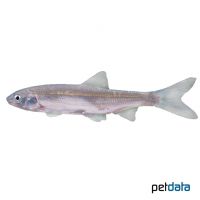Common Nase (Chondrostoma nasus)
| Common Nase Chondrostoma nasus | |
|---|---|
| Name | Common Nase |
| Name Lat. | Chondrostoma nasus |
| Family | Minnows |
| Family lat. | Leuciscidae |
| Order | Carps |
| Order lat. | Cypriniformes |
| Origin | Europe |
| Habitat | Rivers |
| Diet | Omnivore |
| pH | 6.5-7.5 |
| Behavior | Peaceful |
| Keeping | Group |
| Care Level | Moderate |
| Reproduction | Egg scatterer |
| Breeding | Moderately difficult |
| Life Span | 10-15 years |
| Protection | No |
| Metric Units | |
| Size | 30-40 cm |
| Temperature | 4-20 °C |
| Hardness | 5-20 °dH |
| Aquarium | Ponds |
| US Units | |
| Size | 12"-16" |
| Temperature | 39-68 °F |
| Hardness | 89-356 ppm |
| Aquarium | Ponds |
Distribution and habitat
Nase are widespread throughout Central Europe, except in the Elbe River basin. They are bottom-dwelling fish that live in large schools in fast-flowing, oxygen-rich and clear waters with stony-gravelly bottoms. They are rarely found in stagnant waters, such as lakes or reservoirs
Maintenance
For husbandry requires a suitably large pond.
The pond should be furnished with pond, floating and oxygenating underwater plants (water milfoil, water plant, hornwort, etc.), large river pebbles and a substrate of round-grained gravel, as well as provide plenty of free swimming space with strong currents.
No ammonia, ammonium or nitrite should be detectable in the water, and the nitrate value should not exceed 100 mg/l. To ensure the water quality and oxygen content, a filter adapted to the water volume should not be missing.
Diet
They feed on detritus and graze the growth (algae) with the microorganisms living in it from stones with their horny lower lip. The food supply consists mainly of a commercially available sinking special dry food for pond fish (sticks, granules), occasionally supplemented with live or frozen water fleas, mosquito larvae and tubifex as well as vegetable food, such as algae leaves, lettuce, scalded spinach or a dry food with high vegetable content (spirulina).
Only feed as much as will be eaten in a few minutes. Regular and varied feeding promotes health and increases resistance.
Behaviour and compatibility
They are lively schooling fish that do not show any aggressive or incompatible behavior. At least 5, but preferably much more noses should be kept together. They can be socialized well with other peaceful fish
Basically, only compatible fish species with similar demands on water condition and water temperature should be socialized.
Reproduction and breeding
No external sexual characteristics are known.
At spawning time between March and May, they migrate upstream in large shoals and spawn over rocky-gravelly bottoms. The eggs, about 1.5 mm in size, adhere to gravel and stones. After spawning, which lasts 3-5 days, the fish return to their territory
They have a life expectancy of 10-15 years
Important
It owes its name to its extremely underslung mouth, which makes the tip of its head look like a nose. The animals have now become rare due to heavy environmental pollution
If they are hibernated in the pond, it is necessary to ensure sufficient depth and oxygen supply (filter, oxygen dispenser, ice free holder).
At temperatures below 8-10 °C, the metabolism of the fish slows down and no more food is accepted; feeding must be stopped accordingly. If the temperature drops further, they hibernate near the bottom. In spring, with rising temperatures, feeding can slowly be resumed. Feeding may also be necessary during prolonged warm periods in winter.
The well-being of the fish should be monitored regularly. A regular partial water change, according to the pond size is recommended, even if the pollutant load has not yet reached the upper limit. Sudden changes in water quality should be avoided. Newly introduced fish must be accustomed slowly to the water in the pond
Further literature can be found in your pet store.
References
Text: Werner Winter; Image: petdata
Source: BMELV (1998): Tierschutzgutachten - Haltung von Zierfischen (Süßwasser); ENGELMANN (2005): Zootierhaltung - Tiere in menschlicher Obhut: Fische; Harri Deutsch Verlag
- Gemäß § 21 Abs. 5 Tierschutzgesetz idgF
